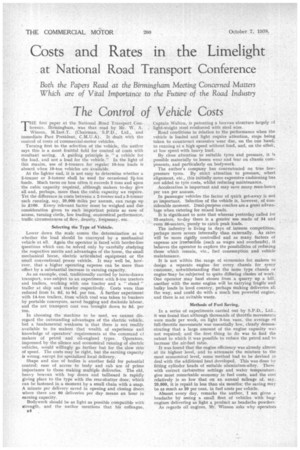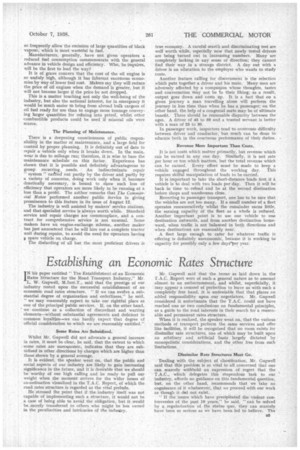_Costs and Rates in the Limelight
Page 38

Page 39

If you've noticed an error in this article please click here to report it so we can fix it.
at National Road Transport Conference
Both the Papers Read at the Birmingham Meeting Concerned Matters Which are of Vital Importance to the Future of the Road Industry The Control of Vehicle Costs THE first paper at the National Road Transport Conference, Birmingham, was that read by Mr. W. A. \Vinson, M.Inst.T. (Chairman, S.P.D., Ltd., and immediate Past President, C.M.U.A), It dealt with the control of costs of commercial-motor vehicles,
Turning first to the selection of the vehicle, the author says this is a most fruitful field for control of costs with resultant saving. A guiding principle is " a vehicle for the load, and not a load for the vehicle." In the light of this maxim, use of 5-tonners for regular 10-ton loads is absurd when 10-ton vehicles are available.
At the lighter end, it is not easy to determine whether a 2-tonner or 3-tonner shall be used for occasional 2i-ton loads. Much turns on how often it exceeds 2 tons and upon the cubic capacity required, although makers. to-day give all and, perhaps, more than the cubic capacity we require. Yet the difference in costs between a 2-tonner and a 3-tormor each running, say, 20,000 miles per annum, can range up to £100. Every relevant factor must be weighed and due consideration given to such important points as ease of access, turning circle, low loading, economical performance, traffic circumstances of flow, density, frequency, etc.
Selecting the Type of Vehicle.
Lower down the scale comes the determination as to whether the load should be conveyed by a mechanical vehicle at all. Again the operator is faced with border-line questions which can be solved only by carefully studying the respective merits and advantages of the horse, the small mechanical horse, electric articulated equipment or the small conventional power vehicle. It may well be, hoWever, that a higher operating expense can be more than offset by a substantial increase in earning capacity.
As an example, coal, traditionally carried by horse-drawn transport, was subject to an experiment with 5-ton tractors and trailers, working with one tractor and a " stand" trailer at ship and trawler respectively. Costs were thus reduced from Is. 6d. to 9d. per ton. A further experiment with 14-ton trailers, from 'which coal was taken to bunkers by portable conveyors, saved bagging and dockside labour, and the net transport cost was brought down to 5d. per ton.
In choosing the machine to be used, we cannot disregard the outstanding advantages of the electric vehicle, but a fundamental weakness is that there is not readily available to its makers that wealth of experience and knowledge of operators' requirements at the command cf makers of petrol and oil-engined types. Operators. impressed by the silence and econotnical running of electric vehicles, would willingly go further but for the slow rate of speed. The costs may he right, but the earning capacity is wrong, except for specialized local delivery. Shape and size of bodies is another field for potential control; ease of access to body and cab are of prime importance to those making multiple deliveries. The old, heavy boxyan with top doors and tailboard is rapidly giving place to the type with the rear-shutter door, which can be fastened in a moment by a small chain with a snap. A minute per delivery saved in opening and closing doors where there are 60 deliveries per day means an hour in earning capacity.
Bodywork should be as light as possible compatible with strength, and the author mentions that his colleague. n4 Captain Walton, is patenting a boxvan structure largely ef light-weight steel reinforced with steel wire. Road conditions in relation to the performance when the vehicle is loaded and light require attention, steps being taken to counteract excessive wear due, on the one hand, to running at a high speed without load, and, on the other, at low speed with heavy load. By close attention to suitable tyres and pressure, it is possible materially to lessen wear and tear on chassis components, and particularly on bodywork. The author's company has concentrated on true lowpressure tyres. By strict attention to pressure, wheel alignment, etc., this initially more expensive cushioning has not added to tyre costs, whilst reducing maintenance. Acceleration is important and may save many man-hours per van per annum. In passenger vehicles the factor of quick get-away is not eo important. Selection of the vehicle is, however, of considerable moment. Dual-purpose coaches are a great advantage when catering for mixed loads. It is significant to note that whereas yesterday called for 32-seaters, to-day there is a greater use made of 34 and even 36-seaters, purely to catch peak loads. • The industry is living in days of intense competition, perhaps more severe internally than externally. As rates will be more rigidly controlled and as many factors of expense are irreducible (such as wages and overheads), it behoves the operator to explore the possibilities of reducing those which remain, viz., fuel consumption and vehicle maintenance.
It is not within the range of economics for makers to design a separate engine for every chassis for very customer, notwithstanding that the same type chassis or engine may be subjected to quite differing classes of work. One operator may haul stones from a quarry up a hill, another with the same engine will be carrying fragile and bulky loads in level country, perhaps making deliveries all the way, and could do with a much less powerful engine, . and there is an evitable waste.
Methods of Fuel Saving.
In a series of experiments carried out by S.P.D., Ltd„ it was found that although thousands of throttle movements were made per week, on light 9-ton vans, the average of full-throttle movements was essentially low, clearly demonstrating that a large amount of the engine capacity wae. not required; and the first thing to do was to find the extent to which it was possible to reduce the petrol and to increase the air-fuel ratio.
It was found that the engine efficiency was already almost at its highest level, and to attenuate the mixture to the most economical level, some method had to be devised to deal with the additional heat developed. This was done by fitting cylinder heads of suitable aluminium-alloy. These with correct carburetter settings and water temperature, give most remarkable economy in fuel costs, and the cost relatively is so low that on an annual mileage of, say, 20,000, it is repaid in less than six months; the saving may be as much as 20 per cent, in fuel costs per vehicle.
Almost every day, remarks the author, I am given el headache by seeing a small fleet of vehicles with huge engines delivering as light a product as headache powders.
As regards oil engines, Mr. \Vinson asks why operators so frequently allow the emission of large quantities of black vapour, which is most wasteful in fuel.
Manufacturers, generally, have not given operators a reduced fuel consumption commensurate with the general advance in vehicle design and efficiency. Who, he inquires, will be the first to lead the way?
It is of grave concern that the cost of the oil engine is so unduly high, although it has inherent enormous economies by way of lower fuel cost. Makers say they will reduce the price of oil engines when the demand is greater, but it will not become larger if the price be not dropped.
This is a matter touching not only the well-being of the industry, but also the national interest, for in emergency it would be much easier tn bring from abroad bulk cargoes of oil fuel ready for uSe than to engage more tonnage conveying larger quantities for refining into petrol, whilst other combustible products could be used if mineral oils were scarce.
The Planning of Maintenance.
There is a deepening consciousness of public responsibility in the matter of maintenance, and a large field for control by proper planning. It is definitely out of date to repair a vehicle only when it breaks down. In the main, wear is due to mileage run; therefore, it is wise to base the maintenance schedule on this factor. Experience has shown that it is possible and definitely advantageous to group recurring needs. An indiscriminate repair " system " carIied out partly by the driver and partly by a variety of concerns, doing work only when it becomes drastically necessary, is bound to show such loss of efficiency that operators are more likely to be running at a loss than a profit. The author remarks that The Commercial Motor performed another public Service in giving prominence to this feature in its issue of August 12.
The industry is well assisted by makers' service stations, and that specialist service is always worth while. Standard service and repair charges are commonplace, and a contract for comprehensive service is not unusual. Some makers have an engine-exchange scheme, another maker has just announced that he will hire out a complete tractor unit during repairs, to avoid the need for operators having g spare vehicle on charge. The disaarding of all but the most profieient drivers is true economy. A careful search and discriminating test are well worth while, especially now that newly tested drivers are being turned out in increasing numbers. Many are completely lacking in any sense of direction; they cannot find their way in a strange district. A day out with a driver is an education to the employer who wants to study costs.
Another feature calling for discernment is the selection which puts together a driver and his mate. Many men are adversely affected by a companion whose thoughts, tastes and conversation may not be to their liking; as a result, output goes down and costs up. It is a fact that on a given journey a man travelling alone will perform the journey in less time than when he has a passenger; on the other hand, the help of a congenial mate may be of ultimate benefit. There should be reasonable disparity between the ages. A driver of 45 to 50 and a trusted servant is better with a man of 25 to 30.
In passenger work, inspectors tend to overcome difficulty between driver and conductor, but much can be done to educate both in the courteous performance of their duties.
Revenue More Important Than Costs.
It is not costs which matter primarily, but revenue which can be earned in any one day. Similarly, it is not rate per hour or ton which matters, but the total revenue which can be earned. Every effort must be made to keep a vehicle engaged throughout the working day. This requires skilful manipulation of loads to be carried.
It is important to take the short-distance loads first if a vehicle is to deal with two loads per day. Then it will be back in time to 'reload and be at the second destination before shops and warehouses close.
Reverting to passenger transport, one has to be sure that the vehicles are not too many. If a small number of a fleet operates remuneratively whilst the remainder earns little, the earning capacity of the fleet as a whole is reduced. Another important point is to use one vehicle to one destination outwards, and from another destination homeward, when traffic is not balanced in both directions and when destinations are reasonably near.
A fleet large enough to cater for whatever traffic is offering is definitely uneconomic, because it is working to capacity for possibly only a few days'per year.




















































































